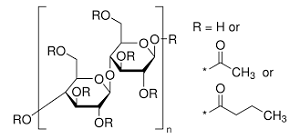HI! I’M ELEMENT AI.
Cellulose Acetate Butyrate

Product Description
Cellulose Acetate Butyrate (CAB) is a thermoplastic polymer derived from cellulose, widely used in various industrial applications due to its excellent properties.
Product:
Cellulose Acetate Butyrate
CAS:
9004-36-8
Synonym:
Cellulose acetobutyrate; Cellulose, acetate butanoate; Cellaburate
Structure:

Typical Characteristics
Appearance
White powder
Density
1.25 g/cm3
Melting point
127-240 °C
Molecular Weight
~70,000
Odor
Odorless
Purity
35-39 wt. % Butyryl
Refractive index
1.475
Uses, Applications & Markets
Key applications
get a quote
We Offer Cellulose Acetate Butyrate
in various grades
A few of the grades available are listed below:



Cellulose Acetate Butyrate used in many
industry applications
Cellulose Acetate Butyrate (CAB) is a thermoplastic polymer derived from cellulose, widely used in various industrial applications due to its excellent properties:
- Coatings and Finishes: CAB is commonly used in coatings and finishes for wood, metal, and plastic substrates due to its excellent adhesion, durability, and weather resistance.
- Inks and Printing: It is utilized in the formulation of inks for flexographic, gravure, and screen printing processes, offering good flow properties, color retention, and adhesion to various substrates.
- Adhesives: CAB-based adhesives are used in woodworking, packaging, and automotive industries for bonding various materials, providing strong and flexible bonds with good resistance to heat and chemicals.
- Surface Protection Films: CAB films are used as protective coatings on electronic displays, automotive parts, and architectural panels to provide scratch resistance, UV protection, and surface gloss enhancement.
- Molded Parts: CAB is injection molded or extruded into various parts and components for consumer products, automotive interiors, and electrical enclosures due to its high impact strength, dimensional stability, and ease of processing.
- Photographic Films: It is used in the manufacturing of photographic films and sheets for its excellent optical clarity, dimensional stability, and resistance to yellowing over time.
- Medical Devices: CAB is employed in the production of medical devices and equipment components such as tubing, syringe barrels, and catheters due to its biocompatibility, sterilizability, and chemical resistance.
- Consumer Goods: CAB is used in the fabrication of consumer goods such as eyeglass frames, sporting goods, and decorative items due to its lightweight, durable, and aesthetically pleasing properties.